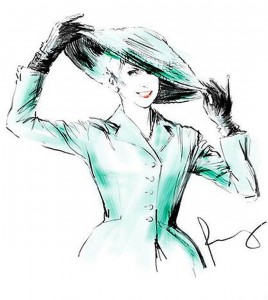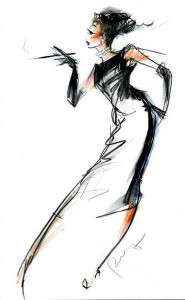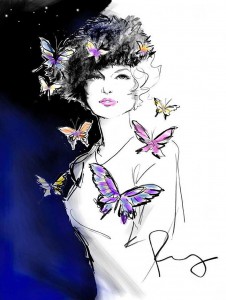By Alexandra Whittaker
A recent resurgence of fashion illustrators at New York Fashion Week shows like Prabal Gurung and Gucci has forced fashion illustration back into the spotlight. With illustration jobs at retail stores like Macy’s and more robust programs for fashion illustration at the School of the Art Institute of Chicago, the city’s fashion illustration community is optimistic about the future.
Chicago native Rosemary Fanti is one of a handful of full-time fashion illustrators. She said fashion illustration has gone from being a fashion staple in the 1950s to diminishing in popularity in the 1960s to recently rising as a niche art.
“It’s keeping alive the individuality, and I think that gets lost in our world sometimes. We become cookie cutters, and we become worried about what our friends think and say of us with social media, so a personalized illustration or something that’s created for you is unusual in this day and age,” said Fanti. “I think that people, once they see it, they start to treasure it.”
Fanti knew she wanted to draw clothes for a living when she made doll clothes with her mom as a child. She has illustrated for Neiman Marcus and Saks Fifth Avenue.
“[Fashion illustration] has taken on a different audience and a different need,” said Fanti. “What used to be more of a necessity, because everything was illustrated prior to the 1960s, now it’s sort of a niche thing.”
The rise of of more accessible photographic technology signaled the end of a large part of the fashion illustration industry. Most fashion illustrators prior to the 1960s were hired to document runway shows, but photography cut illustrators out of the picture.
Lauren Cheri, the founder and president of the Society of Chicago Fashion Illustrators (SOCFI), said that photography almost killed fashion illustration entirely.
“It made it possible for anyone to record anything anywhere, and that really changed the industry a lot,” said Cheri. “But those things can only record what you can see, and they don’t really record the tone and attitude and personality that’s more intrinsic than just the stuff you can see.”
Cheri learned about fashion illustration at the Illinois Institute of Art, and she founded the Society of Chicago Fashion Illustrators as a student. Today, SOCFI has more than 300 members around the world who attend guest speaker events, participate in skill workshops, and discuss design.
“Companies don’t see fashion illustrators as part of their team anymore. It’s more of an outsourced talent now for freelancers, so fashion illustrators have to create their own opportunities and platforms for their work.”
Cheri hopes that creating a community to connect illustrators will help them build platforms and work opportunities, especially since the purpose of fashion illustration has changed so much.
“It’s gone from being something that was originally completely utility-based to something that is completely artistically expressive. It’s still useful now, it’s still a technical conceptual art form, but its taken on a whole new life that its never had since it came back. It’s an expressive thing now, it’s an art form.”
As a member of SOCFI, Fanti credits emerging technology and social media with connecting illustrators worldwide, but she said that too much technology in illustration classes is a problem.
“I look at the computer and Photoshop as another tool,” said Fanti, “But I think unfortunately schools rely solely on that, so in other words, that becomes the only tool.”
Fanti said the best fashion illustration instruction happens by hand.
“When I learned how to draw, I was taught from teachers that are old school. I was taught the way they were taught in the renaissance, in a very specific mathematical way, to teach somebody the practical parts of how to draw,” said Fanti, “And then from there, the artist comes out.”
School of the Art Institute of Chicago professor Steven Miller teaches fashion illustration to Chicago students, and he has been a fashion illustrator himself for 33 years.
Miller said that while SAIC has digital- and computer-illustration teachers, he is a studio professor and teaches students to sketch by hand. Miller’s classes are often a mix of animators, painters and fashion designers, which requires him to work one-on-one with his illustration students.
“Once they get the foundational facts down, I encourage students to go off in their own directions, and I more oversee them individually,” said Miller. “I don’t teach them a style to work or make them work in a certain way.”
Some fashion illustrators like Fanti believe that fashion illustration is more of a creative art, but Miller had a different take.
“The bottom line with fashion is that it’s a product, and the product needs to be sold. It’s not a fine art. Now you can have fine art that’s related to fashion,” said Miller, “But the bottom line is everybody wants to sell. Nobody wants a closet full of their stuff they couldn’t sell, so retail is the strongest push and reason for fashion illustration. It always has been and always will be.”
Miller said that despite this, students should start with drawing before fashion
“There’s always going to be a market for fashion illustrators because there are always those in fashion that want something different,” said Miller. “Anybody that wants to be a fashion illustrator needs to just start drawing.”
For full-time fashion illustrators like Fanti, her work is more about creating a life out of her passion.
“I kind of straddle the sense between illustration and fine art. It’s kind of like blending the two together, with fashion sprinkled in. It’s almost like the new impressionists,” said Fanti. “What I tell people is if you want something literal, take a selfie.”







